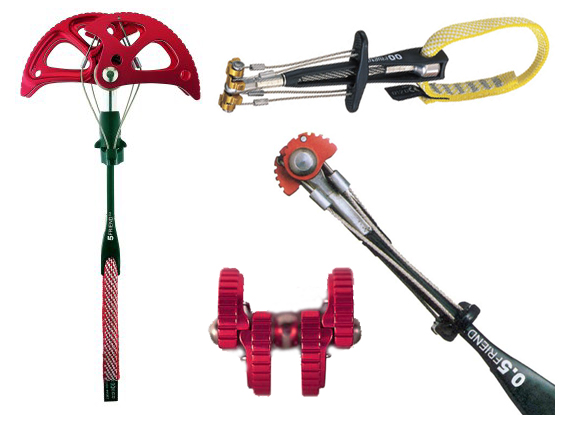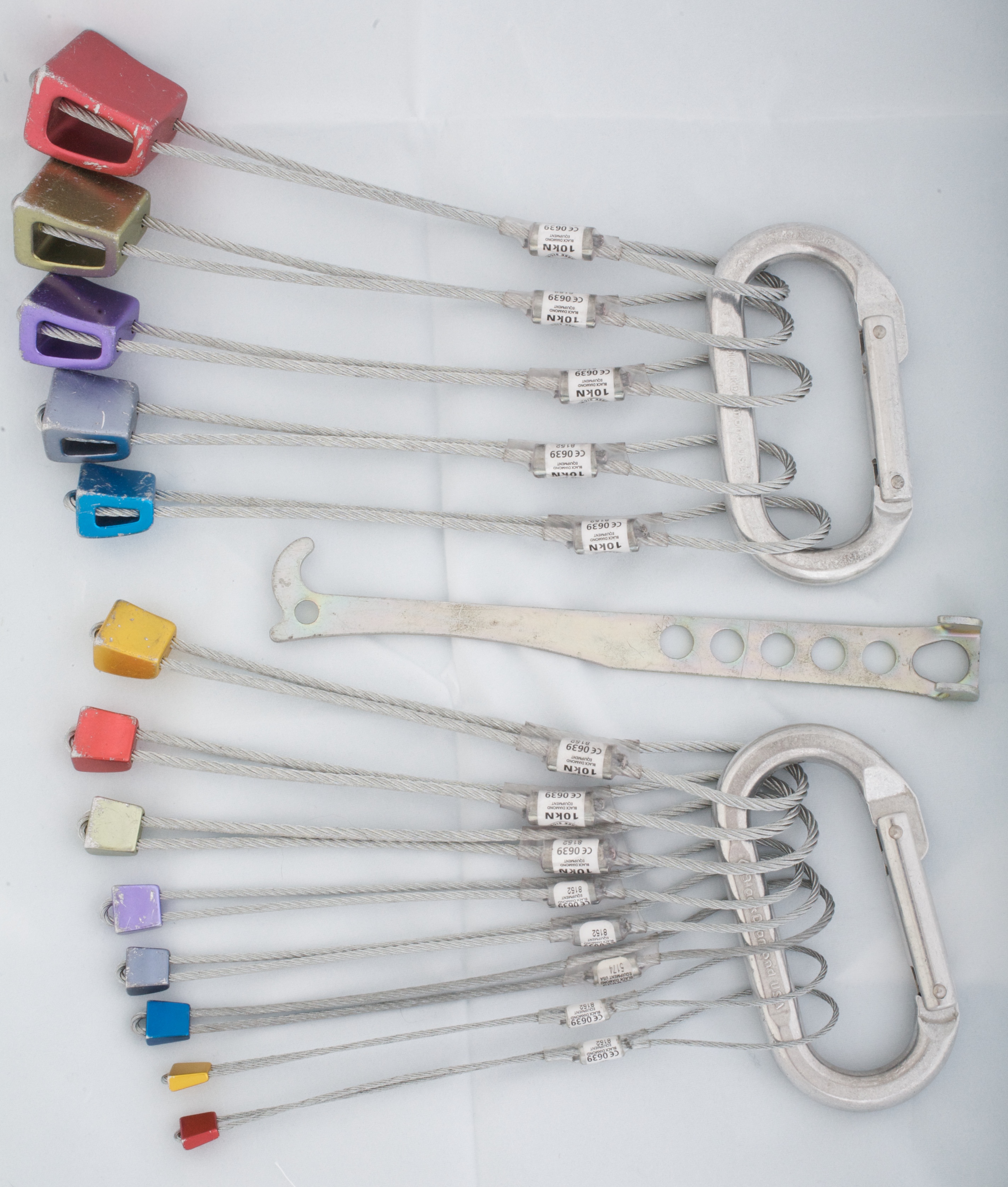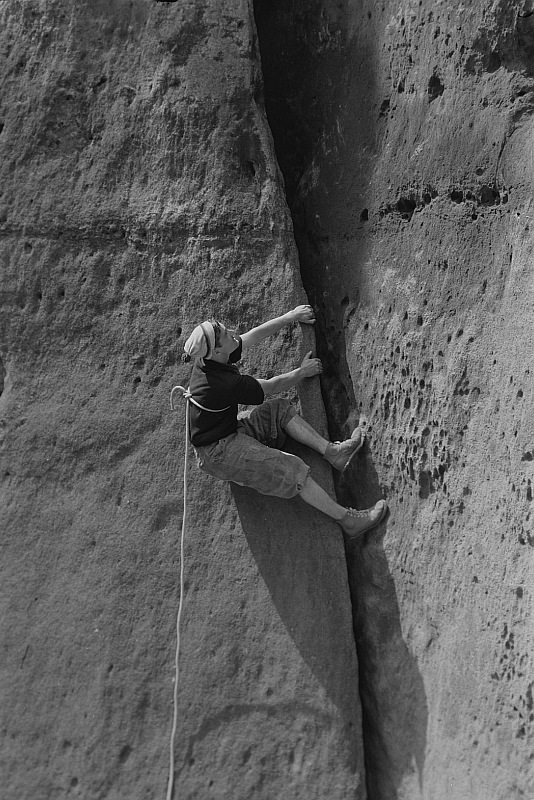|
American Death Triangle
The American Death Triangle, also known as the "American Triangle", "Triangle Anchor"The Mountaineers, 114. or simply the "Death Triangle", is a dangerous type of rock and ice climbing anchor infamous for both magnifying load forces on fixed anchors and lack of redundancy in attachment to the anchor. Description A two-point climbing anchor requires three carabiners: one at each fixed point and one at the "master point" where the load is transferred to the climbing rope. The aim is to distribute the force equally to each fixed point. A triangle anchor is formed by clipping a length of webbing or cord through all three carabiners, creating a shape which gives the dangerous anchor its descriptive name. The force on each fixed point depends on the angle at the focal point. The following table lists the percentage of force transferred to the fixed point for various focal point angles, along with figures for a standard "V" shaped anchor. Table values are derived from vector analysi ... [...More Info...] [...Related Items...] OR: [Wikipedia] [Google] [Baidu] |
Rock Climbing
Rock climbing is a sport in which participants climb up, across, or down natural rock formations. The goal is to reach the summit of a formation or the endpoint of a usually pre-defined route without falling. Rock climbing is a physically and mentally demanding sport, one that often tests a climber's strength, endurance, agility and balance along with mental control. Knowledge of proper climbing techniques and the use of specialized climbing equipment is crucial for the safe completion of routes. Because of the wide range and variety of rock formations around the world, rock climbing has been separated into several different styles and sub-disciplines, such as scrambling, bouldering, sport climbing, and trad (traditional) climbing another activity involving the scaling of hills and similar formations, differentiated by the rock climber's sustained use of hands to support their body weight as well as to provide balance. Rock climbing competitions have the objectives of either ... [...More Info...] [...Related Items...] OR: [Wikipedia] [Google] [Baidu] |
Spring-loaded Camming Device
A spring-loaded camming device (also SLCD, cam or friend) is a piece of rock climbing or mountaineering protection equipment. It consists of two, three, or four cams mounted on a common axle or two adjacent axles, so that pulling on the axle forces the cams to spread farther apart. This is then attached to a sling and carabiner at the end of the stem. The SLCD is used by pulling on the "trigger" (a small handle) so the cams retract together, then inserting it into a crack or pocket in the rock and releasing the trigger to allow the cams to expand. A pull on the rope, such as that generated by a climber falling, will cause a properly placed SLCD to convert the pulling force along the stem of the unit into outwards pressure on the rock, generating massive amounts of friction and preventing the removal of the unit from the rock. Because of the large forces which are exerted on the rock when an SLCD is fallen on, it is very important that SLCDs are only placed in solid, strong roc ... [...More Info...] [...Related Items...] OR: [Wikipedia] [Google] [Baidu] |
Seattle
Seattle ( ) is a seaport city on the West Coast of the United States. It is the seat of King County, Washington. With a 2020 population of 737,015, it is the largest city in both the state of Washington and the Pacific Northwest region of North America. The Seattle metropolitan area's population is 4.02 million, making it the 15th-largest in the United States. Its growth rate of 21.1% between 2010 and 2020 makes it one of the nation's fastest-growing large cities. Seattle is situated on an isthmus between Puget Sound (an inlet of the Pacific Ocean) and Lake Washington. It is the northernmost major city in the United States, located about south of the Canadian border. A major gateway for trade with East Asia, Seattle is the fourth-largest port in North America in terms of container handling . The Seattle area was inhabited by Native Americans for at least 4,000 years before the first permanent European settlers. Arthur A. Denny and his group of travelers, subsequ ... [...More Info...] [...Related Items...] OR: [Wikipedia] [Google] [Baidu] |
The Mountaineers (Pacific NW)
The Mountaineers is an alpine club in the US state of Washington. Founded in 1906, it is organized as an outdoor recreation, education, and conservation 501(c)(3) nonprofit organisation, and is based in Seattle, Washington. The club hosts a wide range of outdoor activities, primarily alpine mountain climbing and hikes. The club also hosts classes, training courses, and social events. The club runs a publishing business, Mountaineers Books, which has several imprints. Publications include '' Mountaineering: The Freedom of the Hills''. Organization and activities The Mountaineers has 7 branches in Western Washington, 3 mountain lodges, and 2 program centers, one in Magnuson Park in Seattle, and one in Tacoma. All classes and trips are organized. History Originally a Seattle-based part of the Mazamas, a Portland based group founded in 1894, The Mountaineers formed their own branch shortly after the 1906 Mazamas Mount Baker expedition and dubbed themselves "The Mountaineers" ... [...More Info...] [...Related Items...] OR: [Wikipedia] [Google] [Baidu] |
Chockstone Press
In rock climbing, a nut (or ''chock'' or ''chockstone'') is a metal wedge threaded on a wire that climbers use for protection by wedging it into a crack in the rock. Quickdraws are clipped to the nut wire by the ascending climber and the rope threads through the quickdraw. Nuts come in a variety of sizes and styles, and several different brands are made by competing manufacturers. Most nuts are made of aluminum. Larger nuts may be threaded on Dyneema cord instead of wire, but this has become unusual. The very smallest nuts are known as ''micronuts'' and may be made of brass or other metal, and typically have their wires soldered into them, instead of looped through drilled holes. They are mostly used in aid climbing, and their value as protection, arresting a climber's fall, is marginal because of both their low breaking strength and their tiny surface area (the HB 0 measures about 4 x 7 x 2.5 mm) in contact with the rock, though this can be offset if several are placed at a ... [...More Info...] [...Related Items...] OR: [Wikipedia] [Google] [Baidu] |
Sling (climbing Equipment)
A sling or runner is an item of climbing equipment consisting of a tied or sewn loop of webbing. These can be wrapped around sections of rock, hitched to other pieces of equipment, or tied directly to a tensioned line using a Prusik style knot. They may be used as anchors, to extend an anchor to reduce rope drag, in anchor equalization, or to climb a rope. Types Slings come both sewn to length and assembled from loose webbing knotted as desired. Common sewn lengths include , , , and . They are available in widths of . Webbing for slings, also known as ''tape'', is sold off the reel, cut to length with a hot knife to prevent fraying, and tied as desired with a water knot. Sewn slings have a rated breaking strength of at least . Short sewn slings are a component of quickdraws, sometimes known as ''dogbones''. Traditionally, slings have been made of nylon. Increasingly, ultra high molecular weight polyethylene sold under the brand names Dyneema, Dynex and Spectra is used. ... [...More Info...] [...Related Items...] OR: [Wikipedia] [Google] [Baidu] |
Rock Climbing
Rock climbing is a sport in which participants climb up, across, or down natural rock formations. The goal is to reach the summit of a formation or the endpoint of a usually pre-defined route without falling. Rock climbing is a physically and mentally demanding sport, one that often tests a climber's strength, endurance, agility and balance along with mental control. Knowledge of proper climbing techniques and the use of specialized climbing equipment is crucial for the safe completion of routes. Because of the wide range and variety of rock formations around the world, rock climbing has been separated into several different styles and sub-disciplines, such as scrambling, bouldering, sport climbing, and trad (traditional) climbing another activity involving the scaling of hills and similar formations, differentiated by the rock climber's sustained use of hands to support their body weight as well as to provide balance. Rock climbing competitions have the objectives of either ... [...More Info...] [...Related Items...] OR: [Wikipedia] [Google] [Baidu] |
Protection (climbing)
Climbing protection is any of a variety of devices employed to reduce risk and protect others while climbing rock and ice. It includes such items as nylon webbing and metal nuts, cams, bolts, and pitons. Different forms of climbing draw on varying forms of protection and the systems that are created from its elements. Types of climbing There are a number of ways to "protect" a climb, varying according to the type of climbing: Lead climbing A lead climber places protection (temporary or permanent anchors) in the rock, snow, or ice establishing a climbing route. The rope is clipped through carabiners (often joined by a short length of webbing into a pair known as a quickdraw) which are in turn connected to the protection. The belayer pays out rope during the ascent, and manually arrests the climber's fall by locking the rope, typically with some form of belay device. Aid climbing Aid climbing involves standing on or pulling oneself up via devices attached to fixed or p ... [...More Info...] [...Related Items...] OR: [Wikipedia] [Google] [Baidu] |
Nut (climbing)
In rock climbing, a nut (or ''chock'' or ''chockstone'') is a metal wedge threaded on a wire that climbers use for protection by wedging it into a crack in the rock. Quickdraws are clipped to the nut wire by the ascending climber and the rope threads through the quickdraw. Nuts come in a variety of sizes and styles, and several different brands are made by competing manufacturers. Most nuts are made of aluminum. Larger nuts may be threaded on Dyneema cord instead of wire, but this has become unusual. The very smallest nuts are known as ''micronuts'' and may be made of brass or other metal, and typically have their wires soldered into them, instead of looped through drilled holes. They are mostly used in aid climbing, and their value as protection, arresting a climber's fall, is marginal because of both their low breaking strength and their tiny surface area (the HB 0 measures about 4 x 7 x 2.5 mm) in contact with the rock, though this can be offset if several are placed at a ti ... [...More Info...] [...Related Items...] OR: [Wikipedia] [Google] [Baidu] |
Best Practices
A best practice is a method or technique that has been generally accepted as superior to other known alternatives because it often produces results that are superior to those achieved by other means or because it has become a standard way of doing things, e.g., a standard way of complying with legal or ethical requirements. Best practices are used to maintain quality as an alternative to mandatory legislated standards and can be based on self-assessment or benchmarking. Best practice is a feature of accredited management standards such as ISO 9000 and ISO 14001. Some consulting firms specialize in the area of best practice and offer ready-made templates to standardize business process documentation. Sometimes a best practice is not applicable or is inappropriate for a particular organization's needs. A key strategic talent required when applying best practice to organizations is the ability to balance the unique qualities of an organization with the practices that it has in commo ... [...More Info...] [...Related Items...] OR: [Wikipedia] [Google] [Baidu] |
Parallelogram Of Force
The parallelogram of forces is a method for solving (or visualizing) the results of applying two forces to an object. When more than two forces are involved, the geometry is no longer parallelogrammatic, but the same principles apply. Forces, being vectors are observed to obey the laws of vector addition, and so the overall (resultant) force due to the application of a number of forces can be found geometrically by drawing vector arrows for each force. For example, see Figure 1. This construction has the same result as moving F2 so its tail coincides with the head of F1, and taking the net force as the vector joining the tail of F1 to the head of F2. This procedure can be repeated to add F3 to the resultant F1 + F2, and so forth. Newton's proof Preliminary: the parallelogram of velocity Suppose a particle moves at a uniform rate along a line from A to B (Figure 2) in a given time (say, one second), while in the same time, the line AB moves uniformly from its position at ... [...More Info...] [...Related Items...] OR: [Wikipedia] [Google] [Baidu] |








